 |
Fort Caswell
Oak Island, North Carolina, USA
|
|
 |
Constructed: 1826-1836
Used by: USA, CSA
Conflict in which it participated:
US Civil War
|
If ever there were a major American fort more physically ill-served by the Confederacy and then the Endicott Board than Fort Caswell, I have yet to discover it. Their combined efforts turned a lovely starfort (albeit with caponiers as bastions) into...that square chunky thing you see above.
|
 |
|
|
The Cape Fear River, which flows 202 miles southeast through North Carolina and meets the Atlantic Ocean more or less at Wilmington, was first explored by Europeans in October of 1662. English explorer William Hinton, Jr. led this mission. He was impressed by its fish, fowl and wildlife, but not by the local inhabitants (Algonquians), whom he described as "very poor and silly creatures," and "theevish." Despite this silly theevishness, he urged Englishmen "not to delay to possess" the river and its immediate surroundings.
Englishpersons first colonized the area near the mouth of the Cape Fear River in 1720. The town that would become Wilmington dates to 1732, although it didn't receive it's present name, after Spencer Compton, First Earl of Wilmington (1673-1743), until 1740.
|
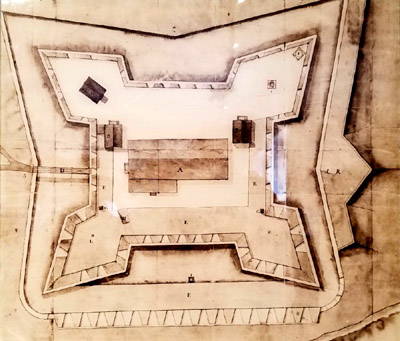 Gorgeous, right? Sorry, but this is not Fort Caswell, but nearby Fort Johnston, as authorities wished it would appear in 1820...the actual Fort Johnston was described as a "small horseshoe-shaped structure." False advertising, 1820 fort plan! Thanks to Fortwiki.com for the image! Gorgeous, right? Sorry, but this is not Fort Caswell, but nearby Fort Johnston, as authorities wished it would appear in 1820...the actual Fort Johnston was described as a "small horseshoe-shaped structure." False advertising, 1820 fort plan! Thanks to Fortwiki.com for the image! |
 |
Where there are settlers, those settlers have stuff, and that stuff is often, at least initially, relatively unprotected. Pirates, privateers and dirty Spaniards took advantage of the woeful lack of defensive fortification in this region. Their attacks spurred North Carolina's Royal Governor, Gabriel Johnston (1699-1752), to initiate construction on Cape Fear's first fort, which coincidentally had the same name as him! Work on Fort Johnston began in 1748.
The workforce was naturally comprised of slaves, which two privateer Spanish vessels attempted to capture later that year. Finding no slaves at work upon their arrival, the Spaniards sailed upriver to the town of Brunswick, where they spent two days looting, taking hostages and generally conducting themselves in an ungentlemanly manner. Local militia eventually chased them back to sea, but a more compelling argument for quickly fortifying the river could not have been made. |
 |
|
Fort Johnston was completed in 1749, and North Carolina garrisoned it with a few dozen militia guys. South Carolina lent ten "small cannon" to the effort, and the Cape Fear River was now closed to all scallawags! Except it wasn't really, because the location and armament of the fort didn't allow it to effectively command the river, and when the scallawags did show up, they approached from the wrong direction.
|
Local Patriots started attacking things in 1775, whereupon Royal Governor Josiah Martin (1737-1786) moved his base of operations to Fort Johnston, where he hatched a plan to arm local slaves. Whether armed slaves would have felt any more affection for Britain than the Patriots is an open question...but it was also a moot question, because the Patriots patriotically determined that they couldn't be having any of that, and captured and burned Fort Johnston. Martin was whisked away by the Royal Navy sloop of war Cruiser, upon which he remained for some time, supplying Loyalists with arms from England.
The British made an attempt to rebuild Fort Johnston in 1778, but one way or another it was destroyed again. After the war local authorities hoped to reestablish Fort Johnston as its bastion on the Cape Fear River, but work proceeded at such a lazy pace (darned coddled slaves!) that by 1810 it was still in "delapidated condition." Fort Johnston eventually attained a horseshoe shape, with a two-story brick barracks and a powder magazine, also made of brick. It was a tiny thing, and certainly no means by which to close the Cape Fear River.
|
 |
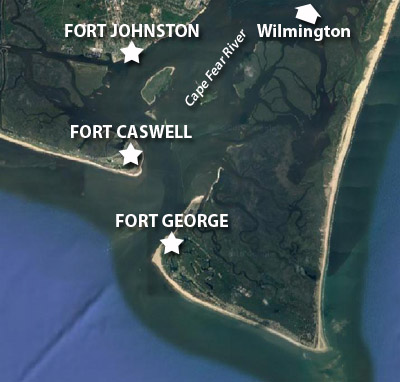 The location of Fort Johnston seems like a strange choice, particularly given where Forts George and Caswell were sited, which certainly appear to be the more obvious strategic locations. The Cape Fear River's navigable channel did pass relatively close to Fort Johnston, but given the "small cannon" that were available at the time, it seems as though its builders were setting it up for failure. They must have known something that I don't, however, as the US military continued to utilize Fort Johnston in one way or another until 2004. The location of Fort Johnston seems like a strange choice, particularly given where Forts George and Caswell were sited, which certainly appear to be the more obvious strategic locations. The Cape Fear River's navigable channel did pass relatively close to Fort Johnston, but given the "small cannon" that were available at the time, it seems as though its builders were setting it up for failure. They must have known something that I don't, however, as the US military continued to utilize Fort Johnston in one way or another until 2004. |
|
The town of Smithville grew around Fort Johnston, in order to house all the folks building the fort, provide things for them, and because it's always safer to live next to a fort, right?
The British also built little Fort George at the mouth of the Cape Fear River in 1776, which rebel troops attempted to attack in September of that year. The Royal Navy was right there, however, and pounded on the Americans until they were forced to retreat. Being but a very small fortlet, Fort George was more of a British presence than a serious attempt to command the river. Having borne all of these ineffectual little fortlings thus far, thank goodness we have a real fort to talk about now!
|
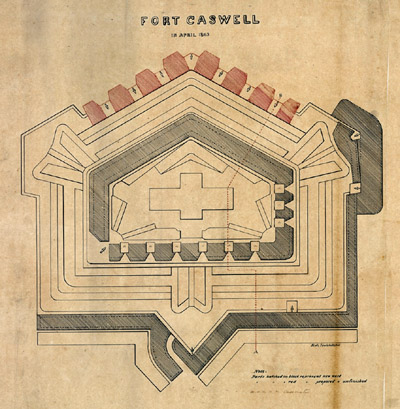 The superduper geometric Fort Caswell, as it appeared in 1863. Click on it to see the whole secret plan! The superduper geometric Fort Caswell, as it appeared in 1863. Click on it to see the whole secret plan! |
 |
In 1821 the Board of Engineers, headed by French engineer Simon Bernard (1779-1839) and US Army Engineer Joseph Totten (1788-1864), submitted three lists of proposed fortification projects to Congress. There were seventeen "Forts of the First Class," sites in most urgent need of fortification for the young United States, such as Fort Jackson and Fort Pike at New Orleans; Fort Monroe in Virginia; Fort Adams in Rhode Island and Fort Warren in Boston Harbor. The "Forts of the Second Class" list, fourteen strong, detailed locations of secondary fortificational importance. These included Fort Morgan at Mobile, Alabama; Fort Sumter in Charleston, South Carolina; Fort Macon at Beaufort, North Carolina and Fort Pulaski protecting Savannah, Georgia...but it also asked for a fortification at Smithville, South Carolina, which would emerge as Fort Caswell. |
|
This project, known today as the Third System of American Seacoast Fortification, was the largest and most expensive endeavor that the United States had ever voluntarily undertaken, and quite frankly it's amazing that Congress had the foresight to go along with it!
|
Fort Caswell was constructed from 1826 to 1836, cost $473,402, and was named for Richard Caswell (1729-1789), first Governor of North Carolina. How can we state this information with such certainty? Because it says it right there above the fort's main gate! All American forts should strive for this level of transparency.
The fort of our current interest was unique amongst American forts in that it boasted six caponiers...no other fort of the period had more than three. Of course if one just builds one's fort with proper bastions, one wouldn't ever have to worry about how to spell, much less pronounce, the word caponier (caponniere).
|
 |
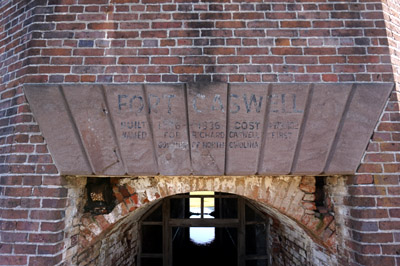 Fort Caswell! Got any questions? Just check the front door! Fort Caswell! Got any questions? Just check the front door! |
|
Fort Caswell was designed to mount slightly over 60 guns, all en barbette, meaning up atop its walls, as opposed to nestled in casemates. This was because guns facing a seaborne enemy were thought to be better protected in casemates, due to the inability of early 19th century naval gunnery to reliably and repeatedly hit a relatively small mark...such as a firing embrasure of a casemate. However, Fort Caswell had a recognized vulnerability to enemy guns placed on nearby islands...and as would later be proven at Fort Pulaski and Fort Macon, modern, long-range guns in static positions were absolute murder on starforts. Guns mounted en barbette could notionally last longer in such a situation, without a surrounding casemate disintegrating atop the heads of a gun crew.
|
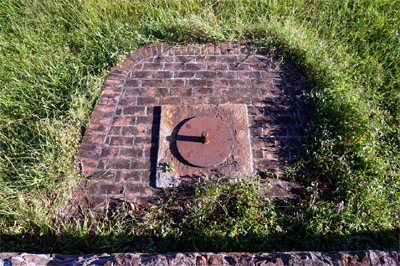 The pintle mount for one of Fort Caswell's guns, atop the north wall. The pintle mount for one of Fort Caswell's guns, atop the north wall. |
 |
Many of the forts constructed in the southern United States in the early/mid 19th century seem to have been built for the express purpose of immediately abandoning them but for a single caretaker sergeant, in order for the rising Confederacy to occupy these forts with a minimum of fuss & bother. Every US Secretary of War from 1849 until the beginning of the American Civil War (1861-1865) was in fact a southerner, all of whom became engaged in either Confederate politics or their military once the south seceded...Jefferson Davis (1808-1889) was Secretary of War from 1853 to 1857, and he went on to become president of the Confederate States of America!
|
|
Whether or not these southern gentlemen actively conspired to de-garrison southern US forts and fill southern US arsenals in the leadup to secession, that's what happened, and they were certainly in a position to make it happen. John B. Floyd (1806-1863), 31st Governor of Virginia and then Secretary of War under President James Buchanan (1791-1868), was accused of scattering the army and filling southern arsenals with Federal ordnance. But then James Buchanan was no prize, either.
|
In many cases, state militias swooped in and captured southern forts shortly after Abraham Lincoln (1809-1865) was elected to be the 16th president of the United States in November of 1860. A North Carolina militia followed suit on January 9, 1861, taking possession of Fort Caswell from Ordnance Sergeant Frederick Dardingkiller, the single Federal soldier stationed therein...only to be ordered to turn the fort back over to the bewildered Dardingkiller by North Carolina Governor John Willis Ellis (1820-1861). Ellis reasoned that North Carolina had not yet seceded from the United States, so there would be no unseemly, premature seizings of Federal property.
|
 |
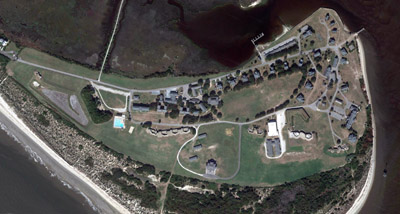 Oak Island, home of the North Carolina Baptist Assembly...and Fort Caswell. Click on the pic to see all of the batteries marked, or click here to see Oak Island unbesmirched by my annoying markup. Oak Island, home of the North Carolina Baptist Assembly...and Fort Caswell. Click on the pic to see all of the batteries marked, or click here to see Oak Island unbesmirched by my annoying markup. |
|
Lest one imagine that Governor Ellis was no friend to the Confederate cause, he also refused President Lincoln's request for North Carolina troops to help put down the ongoing rebellion. The locals' concern was that the wicked Yankees would get their act together and garrison Fort Caswell eventually, so the fort was seized once again by a militia, and immediately ordered unseized again by Governor Ellis. Where was Ordnance Sergeant Frederick Dardingkiller staying during these brief periods of North Carolinian fort ownership? After the second time this happened, surely just pitched a tent nearby and settled in to wait things out. North Carolina finally got around to seceding from the Union on May 20, 1861. Local militias looked at Governor Ellis with pleading eyes and begged, now may we please seize Fort Caswell? Ellis grudgingly relented, and the fort of our current interest became a bastion of the Confederacy on April 16, 1861. Bye, Ordnance Sergeant Frederick Dardingkiller! Enjoy walking to Fort Monroe!
|
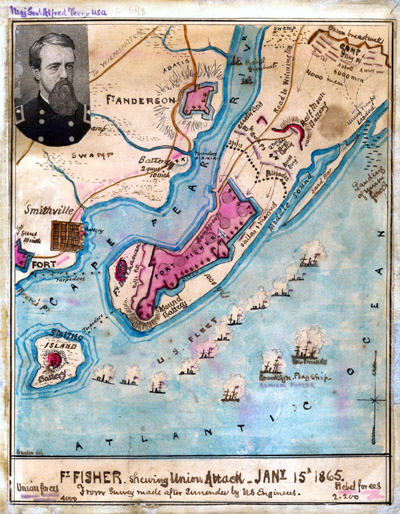 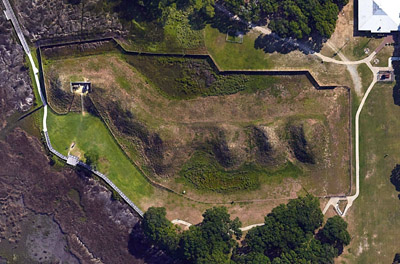 A lovely artistic interpretation of the Union attack on Fort Fisher in January of 1865, based on a survey made by US engineers. Either the engineers or the artist clearly had a pretty loose grasp on the lay of the land, but the "deceased woodland creature"-style beard on US Major General Alfred Terry at the picture's top left more than makes up for any cartographical errors. And, Fort Fisher today. A lovely artistic interpretation of the Union attack on Fort Fisher in January of 1865, based on a survey made by US engineers. Either the engineers or the artist clearly had a pretty loose grasp on the lay of the land, but the "deceased woodland creature"-style beard on US Major General Alfred Terry at the picture's top left more than makes up for any cartographical errors. And, Fort Fisher today. |
 |
Fort Caswell's new owners developed a massive earthwork around the fort, and armed it with 29 guns. The Union never got terribly close to Oak Island during the ensuing American Civil War (1861-1865), but our fort did manage to fire upon US Navy warships, which were blockading the mouth of the Cape Fear River, on several occasions...to no recorded effect. About 10 miles up the Cape Fear from Fort Caswell, at the river's other inlet, was Fort Fisher. This fortification had been initiated in the Spring of 1861, by Confederates interested in defending Wilmington from the marauding US Navy. The importance of Fort Fisher became even more pronounced after May of 1862, when the vast port city of Norfolk, Virginia surrendered to the Union: Wilmington was now the Confederacy's only major deepwater port on the Atlantic. Named for Colonel Charles Frederick Fisher, a North Carolinian who may or may not have been killed in a "friendly fire" incident whilst leading an attack on a Union artillery position during the First Battle of Bull Run (July 21, 1861), Fort Fisher started its life as a rather scrawny artillery battery. By 1864 it was a mile-long earth-and-timberwork colossus, mounting nearly 50 guns facing both the sea and land, with a lit beacon to assist the navigation of blockade runners. Following the capture of Fort Morgan and Fort Gaines in the Battle of Mobile Bay in August of 1864, the Union was ready to make its way up the Cape Fear. Fort Fisher was considered a supremely powerful fortification, and was alternately known as "Southern Gibraltar" and the "Malakoff Tower of the South" (referring to a formidable Russian fortification encountered by the British and French during the recent Crimean War (1853-1856)). |
|
The doughty defenders of Fort Fisher managed to stave off a Union attack on December 24, 1865, but a second attack two weeks later carried the fort. And now 'twill finally be revealed why we were forced to learn so much about Fort Fisher on this page about Fort Caswell! Because once Fort Fisher had fallen, the garrison at Fort Caswell received orders to abandon ship: Spike the guns, burn the barracks and blow up the powder magazines.
|
And blow the powder magazine they did! A witness of the conflagration, located near Fort Johnston, across the Southport Channel from Fort Caswell, described it thus: As I looked, a vivid flash of light shot through the darkness and traveled with lightning rapidity, toward the fort, and then, as if a mighty volcano had sprung its blazing contents from the sea into the sky, a great light flashed up from Caswell, accompanied by a roar and a jar that smashed the glass in our house like a wave of an earthquake.
This explosion was so huge, in fact, that it obliterated Fort Caswell's salient point, along with most of its southeast wall. No sir, them Yankees won't be utilizing this fort agin the Confederacy!
|
 |
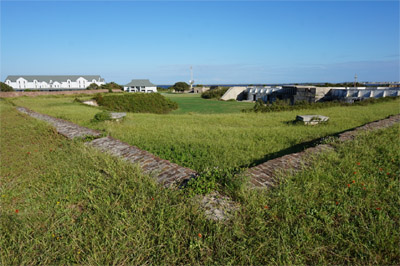 Looking into Fort Caswell from the northwestern tip of its terreplein, straight at the missing wall section. It's disconcerting to see outside a fort when you're looking inside the fort! Looking into Fort Caswell from the northwestern tip of its terreplein, straight at the missing wall section. It's disconcerting to see outside a fort when you're looking inside the fort! |
|
As it turned out, the Yankees didn't need to use the still-smoking Fort Caswell agin the Confederacy, as Wilmington fell to the Union in February of 1865, after which the CSA had a grand total of zero major ports on the Atlantic seaboard. This loss reportedly helped General in Chief of the Confederate Army, Robert E. Lee (1807-1870), come to the conclusion that further Civil Warring was futile: He surrendered to the United States, in the person of Ulysses S. Grant (1822-1885), at Appomattox Court House in Virginia on April 9, 1865.
|
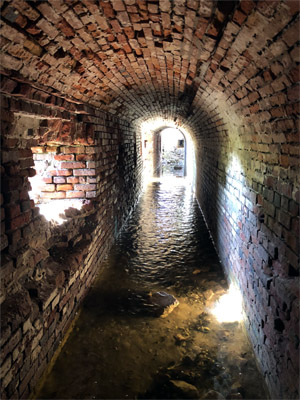 The interior of Fort Caswell's western rifle gallery in October of 2018. One of the coolest things about visiting Fort Caswell these days is that the majority of its infrastructure is flooded, which makes all trompings (sploshings) therein that much more heroic. The interior of Fort Caswell's western rifle gallery in October of 2018. One of the coolest things about visiting Fort Caswell these days is that the majority of its infrastructure is flooded, which makes all trompings (sploshings) therein that much more heroic. |
 |
Fort Caswell's frantically retreating garrison left 29 guns in working order behind, which the boys in blue were more than happy to collect. Those blue persons garrisoned the fort for a few years after the war ended, but by 1872 it was back in caretaker status: Probably not solitarily manned by Ordnance Sergeant Frederick Dardingkiller again, but who knows. Just when America's aging forts were reaching their lowest ebb in the 1880's, in rode Secretary of War William Crowninshield Endicott (1826-1900), on a mighty steel and rebarred concrete horse. He chaired the Endicott Board, which entity took a hard squint at America's seacoast defenses and declared them insufficient to the task of defending those shores from modern European navies. The Endicott Period followed, and it was a bonanza for American starforts. Sort of. The forts built in the first half of the 19th century were already at all of the places that Endicott wished to fortificationally enhance in the 1890's, but those forts built of brick (which was all of them) were unable to mount the enormous steel disappearing guns deemed necessary to smite America's enemies from the seas. Many of these beautiful masonry forts were thus comprehensively uglified with monochromatic concrete. |
|
Not every fort that received "enhancement" during the Endicott Period was cosmetically defiled: Many received new batteries nearby that did nothing to soil the beauty of the original fort, such as at Fort Washington on the Potomac. Some, however, were forever blemished with hideously slabby batteries: Everyone's favorite example of this phenomenon is what happened to Fort Delaware...and Fort Caswell falls firmly into the latter category. Not that there was a whole lot of symmetric grace left at Fort Caswell, with the humongous hole in its side.
|
In all, seven batteries were added to the expanded Fort Caswell complex between 1896 and 1907: Battery Bagley (mounting eight 12" mortars); Battery Caswell (two 12" barbette guns); Battery Madison (originally one 4.7" pedestal gun, which in 1904 was replaced with two 6" disappearing guns); Battery McDonough (originally one 5" balancing pillar gun, which in 1906 was replaced with two 3" pedestal guns); Battery McKavett (two 3" masking pedestal guns); Battery Shipp (two 5" pedestal guns); and Battery Swift (eight 8" disappearing guns).
Fort Caswell also saw the construction of many support structures during this period, because all of these new gun crews needed places to sleep and hang out!
|
 |
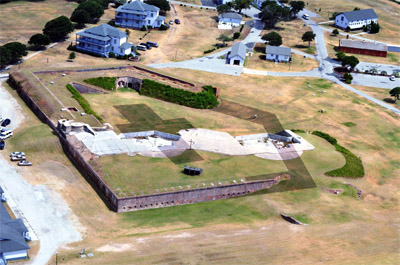 The original shape of Fort Caswell, graciously provided to us by author and Old Fort, John Weaver. The original shape of Fort Caswell, graciously provided to us by author and Old Fort, John Weaver. |
|
All of these shiny new steel guns sat menacingly at Fort Caswell for a few years, until the United States declared war on Germany in 1917. The First World War (1914-1918) was consuming the youth and treasure of Europe, and there was no way the USA was gonna miss its chance to get a piece of that action! The guns of Batteries Madison, Shipp and Swift were removed and shipped to France, where they were unceremoniously dumped on the ground, along with hundreds of other huge guns taken from American forts, in anticipation of a modification for ground combat that never occurred...because America won Europe's war too quickly (fight me)!
|
|
|
Upon the satisfactory conclusion of the second War to End All Wars, Fort Caswell, declared US Government Surplus, was purchased by the Baptist State Convention of North Carolina in 1949. Utilizing the existing infrastructure of the complex and building several new edifices, the North Carolina Baptist Assembly operates Fort Caswell as a year 'round coastal retreat and conference center...and they've done a fine job as stewards of this historic treasure. They have erected a big cross atop Battery Caswell, but ultimately it's their fort and they can decorate it how they choose. I visited Fort Caswell in October of 2018! Click here to see pix & read observations from my visit. Please note that it really isn't much of a gallery yet, but within the next two years or so, I'll be sure to get right on it!
|
|
|
|
|
|
 |




